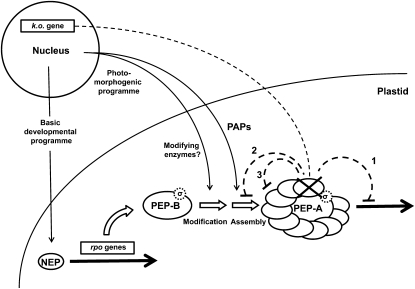Figure 4.
Checkpoint model describing the reconfiguration of the plastid RNA polymerase complex as an essential step in plastid development. The scheme depicts the structural assembly of the plastid-encoded RNA polymerase, starting with the expression of the rpo genes by the NEP enzyme, resulting in the formation of the basic PEP-B enzyme. Interaction with σ-factors is assumed. Upon initiation of photomorphogenesis, it is modified first by posttranslational changes of rpo subunits (via unknown modifying enzymes) and second by the addition of PAPs, generating the structurally more complex PEP-A. White arrows indicate the flow of events required for PEP-A buildup. Thin black arrows indicate the action or involvement of nucleus-encoded proteins delivered in a fixed sequence that follows a distinct developmental program in the nucleus. Thick black arrows indicate transcription activity. Dotted lines indicate the possible impact of a PAP gene knockout in the nucleus on PEP-A. The lacking subunit is indicated by a cross, its inhibitory feedback by dotted lines. Numbers refer to discussed possibilities causing the observed phenotypes of PAP knockout mutants. For further details, see text.

